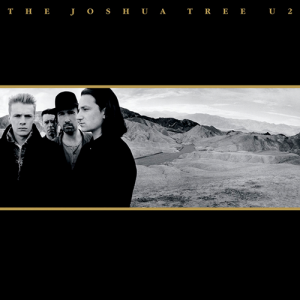U2’s The Joshua Tree was released 25 years ago today: March 9, 1987. It’s not my favorite U2 album; it’s not the album of my U2 discovery; and it didn’t radically change my life (well, beyond the general profundity U2 has had on my life). But it’s just so perfect—arguably their best album, inarguably a masterpiece. And it knows it. As the opening crescendo of “Where the Streets Have No Name” plays, ushering in Edge’s shimmery guitar, the gates of Heaven open, light shines down, and you know you are about to experience something spectacular. “Streets” is a glorious awakening—not just to the song, or the album, but to a band that would change America, and an America that would change the band. (The album’s working title, The Two Americas, references U2’s simultaneous infatuation and frustration with the United States at the time.)
To celebrate the occasion, and because it’s been a long-time goal to take this trip, I’m headed out west for six days to find and visit several sites relevant to the Joshua Tree era of U2—places the band saw as they drove through Death Valley from Reno to Los Angeles in 1986. The topic of spring break plans has naturally come up recently with friends and family and colleagues. What follows is a piecing-together of the many conversations I’ve had about this with people in the last week, months and year.
So, got any plans for spring break?
Yep. I’m headed out to Vegas for a week.
Wow, Vegas! Sounds like fun. Have you seen The Hangover?
Yes, but this trip is less Mike-Tyson’s-tiger-and-roofies and more driving-and-desert. I’m going to visit the site of the actual Joshua tree that inspired the title of U2’s album.
Is the tree still there?
Yes, but it’s dying. The Joshua tree fell in 2000, according to evidence pieced together by fans posting and blogging about their visits. I’ve read estimates that the tree was perhaps 200 years old, so I imagine it’s got a while before turning to dust. But between the ravages of time and of disappointing scavenging U2 fans (tsk tsk), the tree is disappearing. Or at least dwindling. The position of the remains suggest that the large branch fell off, and unable to support its newly imbalanced state, the tree fell over—a fate the band has managed to avoid for more than 30 years.
Ask any fan why he or she likes U2, and the boys’ loyalty to one another and to the band is high on the list. We love them because they love each other. And it’s been the exact same line-up for 99.99999999 percent of the time. If one of them had decided to leave, they would have been felled by their imbalance. Last year’s documentary by Davis Guggenheim, From the Sky Down, revealed how close U2 was to losing a limb after The Joshua Tree and subsequent album, Rattle and Hum—not any one of the members in particular, but each of them, all of them.
So, you’re flying cross-country and spending your entire spring break in the desert looking for a dead tree?
Yes. Most of us put up a dead tree in our houses for two to six (OK, eight) weeks every winter. So, back off. One explanation of the Christmas tree tradition is that the triangular shape of the evergreens represented the Holy Trinity.
Did you just compare visiting a rock band’s dead tree to celebrating Christ’s birth?
Kind of.
Why are you going?
I spend a good deal of my time trying to get closer to U2, or the U2 feeling. During the touring season, I throw a lot of time and money at those spots on the rail. In the off season, I go through rotations with their albums, hearing new sounds and lyrics and meanings every time—few days go by that I don’t listen to a U2 song. I reasearch their history, looking for insight into who they are, why I like them so much and, in turn, who I am. In the last few years, I’ve been trying to visit as many U2 sites as I can. Bono is endlessly inspiring to me, beyond the sex appeal of a successful, foreign-accented, blue-eyed lead singer. He is a good, good person. He has good, good ideas. He has a way of viewing the world and expressing its beauty, its paradoxes and its pains. I think it’s only natural to want to feel connected with someone you admire that much, and to feel connected with others who know the same inspiration. I try to do that by seeing what he’s seen, and standing where he’s stood. This trip is a pilgrimage—one many U2 fans make, knowing good and well the tree fell long ago.
Did you just compare your trip to see the dead tree to a journey of religious devotion?
Yes. Jews, Christians and Muslims have their holy lands. The Greeks made their way to Delphi. I’m going to the tree. They were all making spiritual journeys to places important to their beliefs and their faiths. I’m doing the same.
Do you think you’ll *ahem* find what you’re looking for?
Very clever. And no. The point isn’t to find “it”; it’s to never stop looking. Bono might well have titled that song, “I still am not sure what it is I’m looking for,” but that’s not as catchy.
Are you going alone?
No, I’m going with two girlfriends I met in lines to see U2 shows.
So, you would not know these people any other way except for through U2?
Right. They’ve already been vetted. We all understand the significance of the trip. They are two of the loveliest, purest-hearted girls on earth.
Are you going to do anything else while you’re out there?
Yes. We’re making day trips to see a few other sights relevant to this U2 era. One trip will be to the Harmony Motel in 29 Palms, Calif., where Anton Corbijn photographed the band in front of the motel sign. The motel is right next to the Joshua Tree National Park, home to thousands of still-living Joshua trees. Many people think U2’s tree is at this site, but that’s part of the mysticism and symbolism of its actual location. Joshua trees usually grow in groups; the lone tree in the album imagery caught Corbijn’s eye because of its solitude. Graphic designer Steve Averill has been working with the band since the beginning. It’s exciting to hear him talk about the graphic identity of The Joshua Tree, which was a huge factor in the album’s iconic status.
On our way to the tree, we’ll stop at Zabriskie Point, the mountain range featured on the actual cover of the album. The next day, we’ll drive up to Bodie, a mining town that was abandoned in the 1920s and has been left unchanged. Many of the shots staged here were used in the artwork for the Joshua Tree singles.
Once we get back to Las Vegas, we’ll take a stroll down Fremont Street, where the video for “I Still Haven’t Found What I’m Looking For” was filmed. (A bit of bethandbono trivia: this is the only song I have ever Karaoked.)
Are you taking a camera?
I’m taking three.
Are you going to blog about it?
I hope to, sometime before the album’s 30th anniversary.
Watch out for rattlesnakes.





